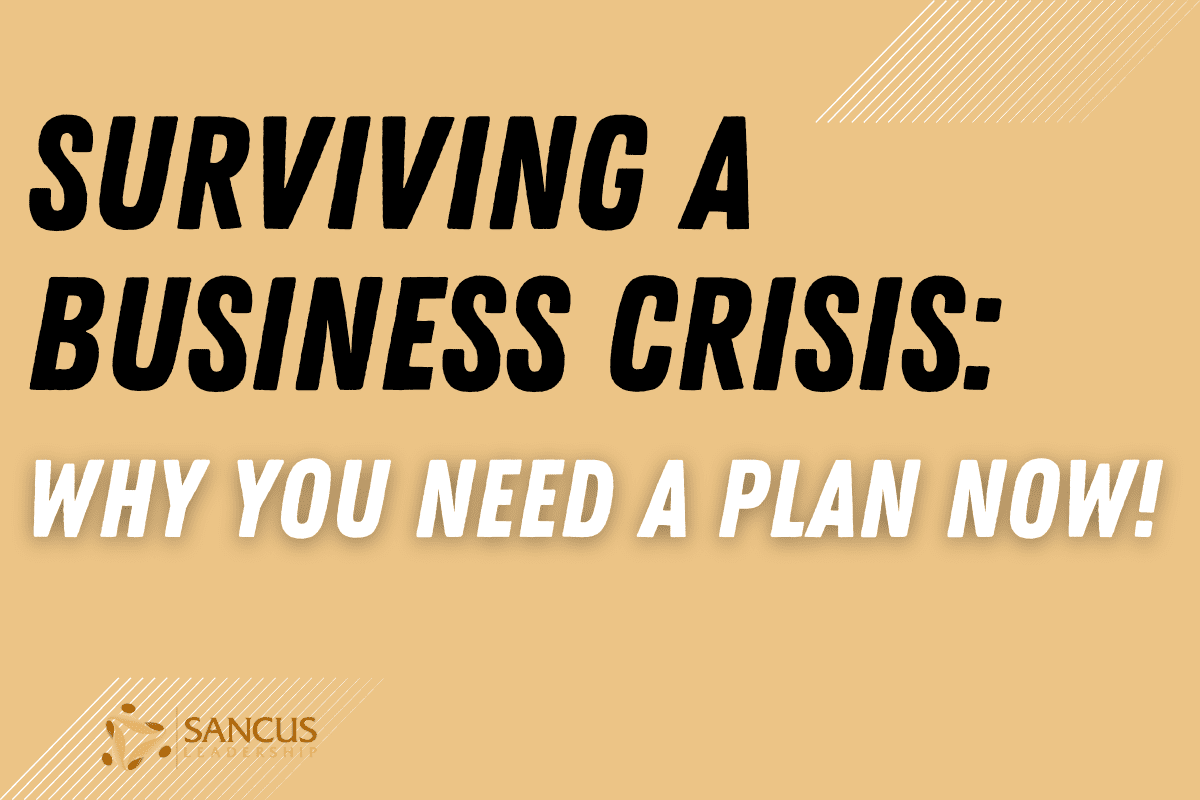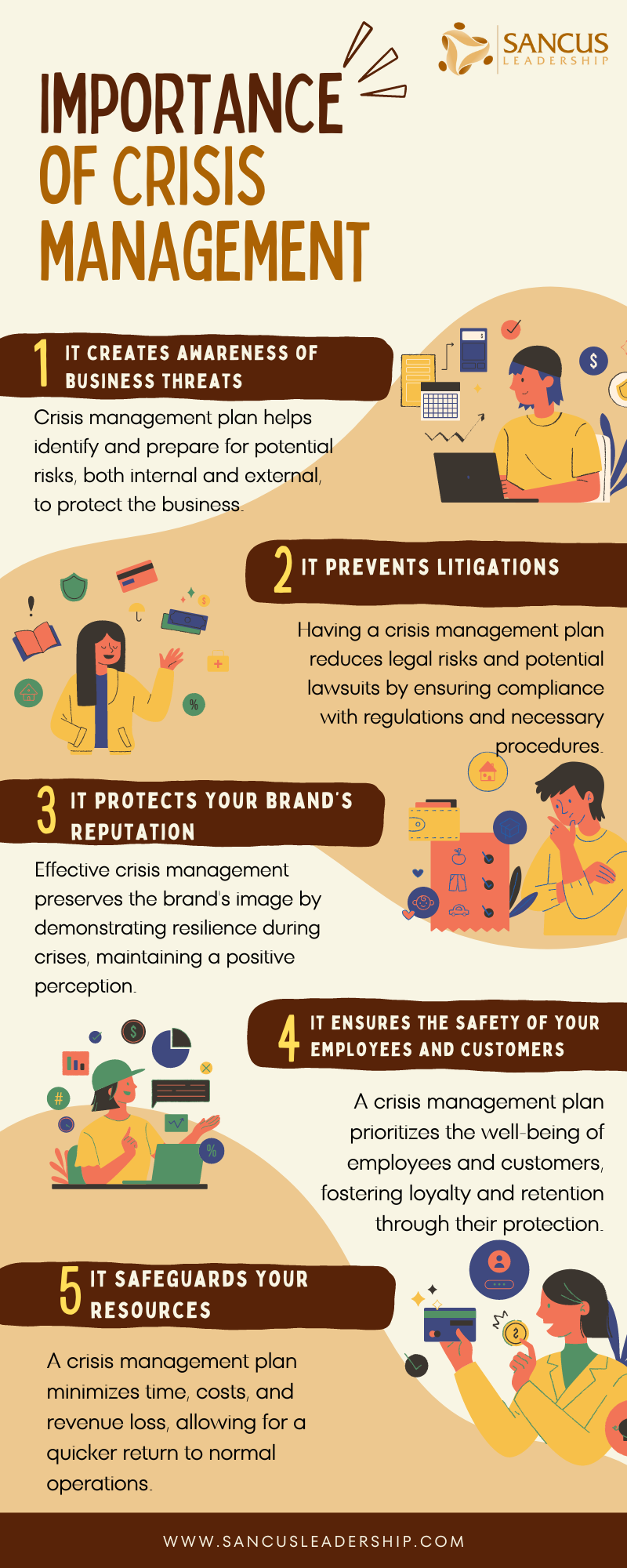Your cart is currently empty!

Does Your Business Need a Crisis Management Plan? Find Out!
In the Military, all we do is prepare for adverse conditions. But having a crisis management plan for a business is still far-fetched for many CEOs and owners. After all, crises have a low probability of occurring. But do you know that 69% of businesses experience an average of three crises in five years, and it takes one to four years to recover?
Your business needs a crisis management plan because crises happen without warning. Being unprepared and unequipped to respond to crisis leads to regular disruptions, some of which may be catastrophic. This can lead to financial losses, loss of customers, and poor brand image.
This article explores what you need to know about crisis management. Let’s dive in.
What Is Crisis Management and Why Is It Important?

By its nature, a crisis is unpreventable and unpredictable. It comes as a surprise and threatens to disrupt the normal operations of a business. The managing team controls how to manage and respond to the crisis in the shortest time possible.
Crisis management takes proactive and reactive measures to restore business operations to normal after a disruptive and unforeseen event. It uses a series of actions to respond quickly to prevent the crisis from escalating to uncontrollable levels.
Since a business faces various types of crises, the efficiency of crisis management lies mainly in having a continuous crisis management framework. Such a framework consists of a proactive and reactive phase.
Since a business faces various types of crises, the efficiency of crisis management lies mainly in having a continuous crisis management framework.
The proactive phase happens when the business is operating smoothly with no chaos. This is the appropriate time for:
- Predicting: It’s impossible to respond to an event you know nothing about. An efficient crisis management framework starts by analyzing and anticipating the risks that the company is likely to face in the foreseeable future.
- Preventing: It involves taking measures to mitigate controllable crises—for example, setting up an internal control system in the accounting department to avoid fraud.
- Preparing: After making a list of all potential crises, the next thing is to define the ideal response and the implementation approach.
On the other hand, the reactive phase starts when the first signs of a crisis unfold to when you respond to the situation. It involves two key activities:
- Action: It’s the process of implementing your crisis management plan. You send orders and instructions to all stakeholders and ask them to hold their position to manage the crisis.
- Post-action and assessment: After the crisis passes, the next thing is to review how the plan played out. If it worked efficiently, you would maintain it. If not, update it for better performance when the crisis occurs again.
Importance of Crisis Management
Having a crisis management plan benefits your business in the following ways:
- It creates awareness of business threats: The futuristic approach of crisis management exposes most of the significant future threats a company will likely face. Whether the threats are internal or external, you can prepare in advance how you’ll respond to safeguard your business.
- It prevents litigations: Some business threats have legal implications. For instance, if you have a financial crisis and no compensation insurance, your employees can sue you. With a crisis management plan, you’ll identify the procedures necessary to ensure your company complies with regulations.
- It protects your brand’s reputation: If a crisis occurs, for example, a fire breakout in your restaurant. And you have no fire extinguishers despite having a high risk of a fire breakout, which taints your brand image. On the other hand, if a fire breaks out and you have all the resources to manage it, it paints a positive picture of organizational resilience.
- It ensures the safety of your employees and customers: A threat can risk the lives of your employees or customers. But with a crisis management plan, they’ll know their lives are protected. This can increase brand loyalty and employee retention because you’re looking out for them.
- It safeguards your resources: When you have a crisis management plan, you prepare resources early and know the process to follow to get things back to normal. As a result, you save time and inflated spending for placing urgent orders. Also, you resume normalcy sooner, minimizing excessive loss of revenue.

How To Create an Efficient Crisis Management Plan

When a crisis hits, the leading team’s judgment gets clouded. Wrong choices can worsen the situation if there’s no organized plan of what to do and who to do it. To avoid this, you should prepare a crisis management plan.
Wrong choices can worsen the situation if there’s no organized plan of what to do and who to do it.
5 Elements of a Crisis Management Plan
Risk Analysis
Risk analysis aims to identify the threats that could negatively impact business operations. All risks are not equal. Some may have catastrophic effects on the business, while others may have mild effects.
The analysis helps trace the triggers and determine the damage level. You can rank the risks in order of probability. Some common crises that a business might face include:
- Natural crises: These are calamities that occur without the influence of human beings. Examples include pandemics such as the coronavirus, earthquakes, or storms.
- Technological crisis: As you incorporate technology into your operations, you will likely encounter technical malfunctions that can hinder you from meeting customers’ demands.
- Financial crises: These crises revolve around money, one of the most critical assets in the smooth running of a business. They can result from various reasons, such as lack of proper financial records, economic recessions, and lack of product demand.
- Personnel crises: When key personnel affiliated with your brand fail to uphold the business values and engage in unethical practices, it may taint the brand’s image in the eyes of the public.
- Legal crises: These crises result from engaging in illegal activities, failing to pay taxes, or failing to comply with government regulations.
Response Plan
A response plan outlines what the crisis team should do in a crisis. It also defines what warrants a crisis or the signs the managing team should look for to activate the response plan. A sound response plan helps address the crisis by priority and ensures adequate resources are allocated.
Crisis Team
A successful crisis management plan should have a crisis management team. These are individuals who oversee the planning and activation of the response plan. To ensure smooth communication and coordination, the crisis team should have a structured hierarchy of authority. It should define the emergency contact and who should give orders to who.
It is important for leaders to understand that not all leadership styles are effective during times of adversity.
Awareness and Training
Having a great crisis management plan can make you feel secure. However, the plan may be ineffective if the operation team is not aware or well-equipped to respond to the crisis. Your crisis management plan should have a section explaining the strategy for training all employees about the crisis the business faces and the response actions.
It should also equip all team players with the skills to respond effectively in a crisis. For example, teaching cooks in a restaurant to use fire extinguishers.
Maintenance Plan
Crisis management should be a continuous process. A maintenance plan helps review the crisis management plan after a pre-determined period. It reveals weaknesses in crisis response and the lessons learned from previous crises. It also exposes emerging potential risks the business could face in the future.
| Elements of a Crisis Management Plan | Short Description |
| Risk Analysis | Identifies potential threats to the business and categorizes them by severity. |
| Response Plan | Outlines the steps the crisis team should take in response to a crisis and defines the criteria for activating the plan. |
| Crisis Team | Consists of individuals responsible for overseeing and implementing the crisis management plan, with a clear hierarchy of authority and emergency contact information. |
| Awareness and Training | Ensures all employees are aware of potential crises, trained to respond effectively, and equipped with necessary skills and knowledge. |
| Maintenance Plan | A continuous process of reviewing and updating the crisis management plan, identifying weaknesses, and addressing potential emerging risks. |
Steps of Creating a Crisis Management Plan
1. Create a Crisis Management Team
To create a comprehensive and actionable crisis management plan, you need insights from experts in different areas of the organization. The crisis team should consist of at least five people who hold key positions in each department.
To create a comprehensive and actionable crisis management plan, you need insights from experts in different areas of the organization.
The critical departments that should have a representative in the crisis team include:
- Risk management to ensure compliance with regulations when handling a crisis.
- Human resources to advise how crises will impact employees and to manage employees during and after an emergency.
- Finance and accounting to determine the financial preparedness of the company in dealing with crises. Also, to identify the financial crisis that the business is exposed to.
- Legal to provide counsel on the possible legal crisis that can result from business activities when dealing with employees, customers, and suppliers.
- Project management to analyze how crises will affect different projects and the best course of action.
- Information technology to provide expertise for dealing with technological crises.
2. Do a Crisis Analysis
Once you have a leading team in crisis management, proceed to the most demanding yet critical step in crisis management. You’ll analyze each department and predict all the crises that are likely to occur.
This is where the beauty of having an expert from every department comes in. Since they understand the ins and outs of the department, it’ll be easy to point out major and minor troubles that are worth preparing for.
It would help if you also determined how each crisis impacts the business and the cause and ranked them by the severity and probability of happening.
3. Develop a Response Plan
Because most crises, such as natural disasters, are unpreventable and unpredictable, a crisis management plan should focus more on responding than preventing. In this step, you build the resilience of your business by developing a response strategy to minimize the impact of a crisis.
The response plan should highlight the resources, choices, and actions necessary to restore normalcy in the business. When making a response plan for each crisis, you should ensure that:
- The actions are ethical and compliant with industry rules and regulations.
- It protects the brand’s reputation internally and externally.
- It safeguards and reduces the wastage of financial and material resources.
4. Assign Crisis Response Duties
Assigning duties before a crisis eliminates confusion and poor judgment because everyone knows what is expected of them. Before assigning duties, you should structure the hierarchy of authority. The leading team should comprise four key personnel:
- A crisis leader: This is the individual who oversees the overall crisis management process. Everyone should answer directly or indirectly to them. The person does not have to be an existing manager in the organization.
- Command center manager: The individual in this position acts as an assistant to the crisis leader. They receive orders from the crisis leader and pass them on to the crisis team.
- Communication manager: They are responsible for the efficient flow of information internally when dealing with crises and externally when responding to the media.
- Subordinate leaders: These are other members of the crisis team who help activate the crisis response by managing the employees in crisis.
Once you structure the leadership team, next comes assigning specific roles to individuals depending on their personality, capabilities, and experience. Sensitive roles that have a significant impact on the business should have a backup person to fill the gap should the crisis occur when the primary person is absent.
Sensitive roles that have a significant impact on the business should have a backup person to fill the gap should the crisis occur when the primary person is absent.
5. Training and Coordination
The training aims to equip professionals unfamiliar with crisis management with the knowledge and skills necessary to deal with a crisis. Some topics that the training session should cover include the following:
- Crisis orientation: This lesson creates an awareness of the business’s crisis and the effect each has on normal operations.
- Crisis mitigations: It covers actions that can prevent a crisis from happening.
- Crisis response: This is the theory part that informs employees of their roles, when they should take action, and to whom they should report.
- Practical: This lesson aims to introduce the tools needed to respond to a crisis and teach employees how to use them.
6. Follow-up and Update
The business may expand, recruit more employees, and introduce a new management structure. After training your employees, you can rest assured knowing you’re better prepared to respond to any crisis. However, a crisis may take a long time before it occurs.
In such an event, you should have a defined period after which the crisis management plan should be reviewed and updated. Also, after a crisis, you evaluate how efficient the crisis response plan was and bridge the weaknesses you identify.
| Steps of Creating a Crisis Management Plan | Description |
| Create a Crisis Management Team | Create a team of experts from different areas of the organization who hold key positions in each department to provide insights and develop a comprehensive and actionable crisis management plan. |
| Do a Crisis Analysis | Analyze each department and predict potential crises that are likely to occur, considering their impact on the business and ranking them by severity and probability of happening. |
| Develop a Response Plan | Develop a response strategy that focuses on minimizing the impact of a crisis, highlighting the resources, choices, and actions necessary to restore normalcy in the business. |
| Assign Crisis Response Duties | Structure a hierarchy of authority and assign specific roles to individuals based on their personality, capabilities, and experience, with sensitive roles having backup personnel in case of absence during a crisis. |
| Training and Coordination | Conduct training sessions to equip professionals unfamiliar with crisis management with the knowledge and skills necessary to deal with a crisis, covering topics such as communication, decision-making, and problem-solving. |
| Follow-up and Update | Review and update the crisis management plan at defined intervals, evaluating its efficiency after a crisis and making necessary adjustments. |
Here’s a quick and informative video discussing 12 Crisis Management Strategies.
Final Thoughts
All businesses, big or small, face universal and industry-specific risks. Having a crisis management plan ensures no crisis catches you off guard. It helps you prepare your employees and keep resources ready for an organized and efficient response to the crisis. It also saves your reputation and finances while keeping all the business stakeholders safe.
